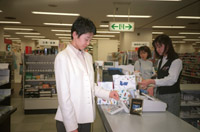|
Top Picks || Arts & Entertainment || Business & Economy || Education & Society ||
SHIBUYA GOES CASHLESS: Tokyo Area Hosts Major E-Money Trial September 8, 1998  It remains to be seen whether e-money purchases will become widespread in the future. (Jiji Press) The downtown commercial area of Shibuya in Tokyo is now hosting the world's largest-ever electronic-money trial. With a host of other trials under way, including those of a similar scale planned for the neighboring Shinjuku district and other population centers near Tokyo as early as spring 1999, e-money is being groomed for the transition to full-fledged commercial use in Japan. These large-scale trials in big cities are aimed at solving two major problems obstructing wider use: the cards' cost and their limited acceptance. Counter Offensive in Shibuya The Shibuya trial, which began in mid-July, involves 800 shops, restaurants, and bars within a 1-kilometer radius of the huge station. The plan is to raise the number of participating establishments to 2,000 by October 1999, so that a successful switch to more widespread use can be made. In the system, monetary value is stored electronically on a smart card, so there is no need for shoppers to carry cash around. The e-money card is suitable for purchases involving sums too small for credit-card payments. Because card users do not need to undergo credit screening, even students and others without a steady income can use it. Trial e-money programs began popping up in cities in Europe and the United States from around 1995 and across Japan from around 1996. They were generally rather limited, typically involving student cooperatives or neighborhoods near city railway stations in the provinces. In the Shibuya experiment, however, cards are being provided by 10 banks and 10 credit-card companies, making it a much larger undertaking. With the beginning of a similar trial in early spring 1999 in Shinjuku, another major Tokyo commercial district, efforts to get e-money cards into everyone's pockets and accepted as a general shopping tool will really get into swing. Cost and Convenience the Key The burden on retail outlets is expected to be considerable, as they will also have to pay a commission on sales by e-money. If many of them opt to stay out of the system, growth in card holders will stall. And if that happens, it will not be possible to bring down costs and commissions, creating the same vicious circle that has plagued many trial runs so far. Manufacturers of cards predict that their price will fall to less than half of current levels in three or four years. But to bring down costs for the system as a whole, standardization of equipment among all operators will be necessary. At the moment, different systems and different cards are in use, meaning that a cardholder can only patronize outlets that take his or her version of e-money. As things stand, the benefits of cashless transactions are not proving very great. Still, even the widely-used credit card has taken nearly 30 years to establish itself. Many in the business believe that e-money could take off within three to five years, if the cards can be made much cheaper and widely usable, and if they can be made multifunctional--for example, serving also as identification tools for use in bureaucratic procedures like residence registration.
 Edited by Japan Echo Inc. based on domestic Japanese news sources.
Articles presented here are offered for reference purposes and
do not necessarily represent the policy or views of the Japanese
Government. Edited by Japan Echo Inc. based on domestic Japanese news sources.
Articles presented here are offered for reference purposes and
do not necessarily represent the policy or views of the Japanese
Government.
|
